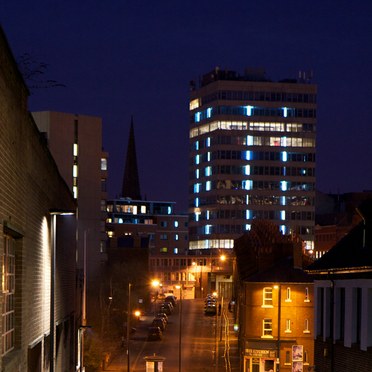Garden Street Area, Sheffield, UK
- Lamp efficacy
Lamp efficacy
Ensuring the lamp efficiently converts electricity into light (lm/W).
- Ballast classification
Ballast classification
Controlling the electricity supply to the lamp (Energy Efficiency Index).
- Luminaire distribution
Luminaire distribution
Controlling light emission using optics which bend and shape the light to the correct location.
- System efficacy
System efficacy
Combining optical and thermal control within the luminaire (luminaire lm/W).
- Presence/absence detection
Presence/absence detection
Providing lighting only when it’s needed.
- Daylight detection
Daylight detection
Reducing waste light during daylight hours.
- Constant illuminance
Constant illuminance
Producing the correct lighting levels for the duration of the maintenance period.
- Task-scene setting
Task-scene setting
Allowing the user to set scenes and adapt the lighting to different tasks.
- Timed off
Timed off
Automatic cut-off to turn all lights off during unoccupied hours.
- Task lighting
Task lighting
Lighting task areas with the correct amount of light.
- Zoning of lighting
Zoning of lighting
Zoning lighting in accordance to occupancy patterns or window location.
- Maintenance schedule
Maintenance schedule
Tailoring maintenance schedules in accordance to product age, performance and environment.
- Waste light
Waste light
Eliminating waste light which does not hit the intended target.
- Reflectance
Reflectance
Taking advantage of light which is reflected from the surface within the space.
- Visible smart metering
Visible smart metering
Enabling results of actions to be quickly seen as increased or decreased energy use to encourage responsible energy consumption.
Sheffield City Council enjoys better light using less energy with Oxane road lanterns
Sheffield City Council have installed Oxane LED complete with sophisticated ground breaking CMS technology to provide the city with a lighting scheme to be proud of. Oxane LED has been chosen as the luminaire to replace old lighting units in the Garden Street Area of Sheffield. If these ongoing installations are successful, and already they look good, the city will look to refurbish more streets using LED technology in the coming years. This will enhance the night time street scene, contribute to reducing the fear of crime and will significantly contribute to energy reduction which supports the authority’s carbon reduction commitment.
The objective of the replacement scheme was to replace life expired equipment with lighting units that provided good quality lighting at appropriate lighting standards whilst reducing energy consumption to a minimum. The lighting from the existing luminaires was a mixture of SON & SOX lamps which produce poor colour rendering and poor uniformity of light within the area. The lead engineer Jonathan Skill wanted to reap the energy reduction benefits available by considering the variation in pedestrian and vehicle usage and tailoring the CMS technology to dynamically reduce or enhance as necessary the level of illumination of this inner city location.
By using an LED solution for the scheme the Council were able to have instant light with exceptional colour rendition properties, which allowed the Council to reduce the lighting standard by one class as allowed for in the current British Standards for S class illuminance levels on the highway. In this case the road lighting classification was reduced from S3 Lighting Class to S4. This reclassification of roads based on the colour quality of the lighting is common practice in the UK and is agreed in the relevant lighting standards, and offers significant benefits in energy reduction.
Sheffield also have the benefit of extra energy savings through using Oxane LED coupled with CMS technology as it allows them to ‘trim’ the switching times giving instant energy savings which is directly related to the light level chosen, it also increases the LED life without affecting efficiency. Their chosen lighting management system will enable them to tailor their lighting levels according to local events , should this ever be a requirement, for example heavy traffic density or increased pedestrian traffic around local events can be immediately responded to if necessary.
The City Lighting Engineer Bob Stevenson stated that "In using Oxane LED together with CMS technology we are able to tailor lighting levels to specific times ensuring we have the appropriate lighting standard for the pedestrian and traffic flows and have the ultimate dynamic control to only pay for energy consumed".

